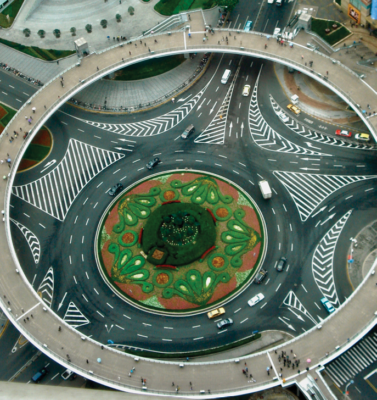In college, my friends and I loved listening to a spoof called “The Never-Ending Traffic Circle” by Firesign Theater about a driver who couldn’t seem to find his way out to the other side. Not everyone had experienced one of these traffic calming and regulating wonders, but they all understood the concept. I, on the other hand, had driven them in New Jersey, where they eliminated the need for traffic signals, easing traffic into continuous motion without the need to stop (yielding still was required) and slowing traffic across the confluence of multiple intersecting roadways. For those who aren’t sure they have seen a traffic circle is, look for aerials of Paris’ Arch of Triumph, which is encircled by eight traffic lanes connecting twelve intersecting roads.
Traffic circles can trace their American origins to Pierre L’Enfant’s street design for Washington, DC in the 1790s, allowing avenues running on a grid to intersect others coming in from 45-degree angles. Dupont Circle is possibly the most well-known of these. More than a century later, New York City gained its famous Columbus Circle. After a big surge in engineering popularity in the 1930s, circles fell out of favor due to being deemed dangerous because drivers didn’t properly yield. At the time, entering traffic had the right of way and traffic in the circle was supposed to yield. Giving priority to incoming traffic can allow more vehicles into the circle than it can handle, resulting in congestion and more likelihood of crashes as a result of both crowding and impatience. In response, some places replaced traffic circles with traditional signalized intersections.
But it’s time to put our geometry caps back on, because variations on traffic circles (also called rotaries) have been making a big comeback. Reversing who yields and who keeps going has made a big difference in safety: those entering now must wait. Still, not everyone loves them, as they can be confusing to enter and exit until used to them. The evolution from rotaries to what are now called roundabouts is infiltrating both residential and urban roadscapes, so refreshing our understanding is in order.
Roundabouts and traffic circles differ in several ways. On roundabouts, traffic control is by giving priority to circulating vehicles and making entering vehicles yield, while some traffic circles use stop control at one or more entries, and in some instances may still require circulating traffic to yield to incoming vehicles. Roundabouts allow pedestrians only to cross the intersecting roads, or legs, essentially prohibiting access to the central island, while some traffic circles allow pedestrian access to that inner circle, often via a signalized crosswalk or, a la Arch of Triumph, an underground passageway. As for parking, it is prohibited at roundabout entries or in the circulatory roadway, but allowed in some traffic circles. Finally, the direction of traffic is counter-clockwise in roundabouts, passing to the right of the central island, while some traffic circles allow vehicles to turn left just before entering the circle.
Additional design elements may apply to roundabouts. At vehicular entry points, splitter islands separate entering and exiting traffic while serving to slow down entering traffic (and providing a refuge for pedestrians). Entry ways may also include flares, widening the approach to multiple lanes to allow for additional traffic capacity both inside the roundabout and in the line of vehicles waiting for entry.
The planning and design of roundabouts merited several documents from the Federal Highway Administration. “Roundabouts: An Informational Guide” (Publication FWHA-RD-00-067, available online at https://www.fhwa.dot.gov/publications/research/safety/00067/00067.pdf) comprehensively addresses everything from planning to community outreach to traffic operation to landscaping to geometric design. It also cites safety statistics (for euphemistically named “conflicts” and more directly addressed crashes) for a variety of circumstances, including lessons learned from European counterparts. A shorter single point document is entitled “Roundabouts: A Proven Safety Solution that Reduces the Number and Severity of Intersection Crashes” (Publication FHWA-SA-10-005, Intersection Safety Brief 14, downloadable from https://safety.fhwa.dot.gov/intersection/other_topics/fhwasa10005/brief_14.cfm)
Keep in mind that the regularly-shaped roundabouts primarily described in these documents are not the only designs we may be called upon to survey and lay out. They may not even all be at the same elevation: see the elevated pedestrian roundabout in Shanghai, China, which gave me vertigo but fantastic views. Then there are “dog bone” roundabouts, which look like circles squeezed in the middle, and “dumbbell” roundabouts with two roundabouts connected by parallel traffic lanes. Configurations new to me are “hamburger” roundabouts in which the center island is crossed by the main road, “turbo” roundabouts with raised lane dividers or markings to keep drivers in their lanes, and “flower” roundabouts with slip lanes for right-hand turns. For more on these variations, see the National Motorists Association e-Newsletter posted at https://www.motorists.org/alerts/is-it-the-golden-age-for-roundabouts-nma-e-newsletter-367/. Those of us who weren’t fond of calculating spirals may need to brush up on those skills to accommodate new traffic control construction.
